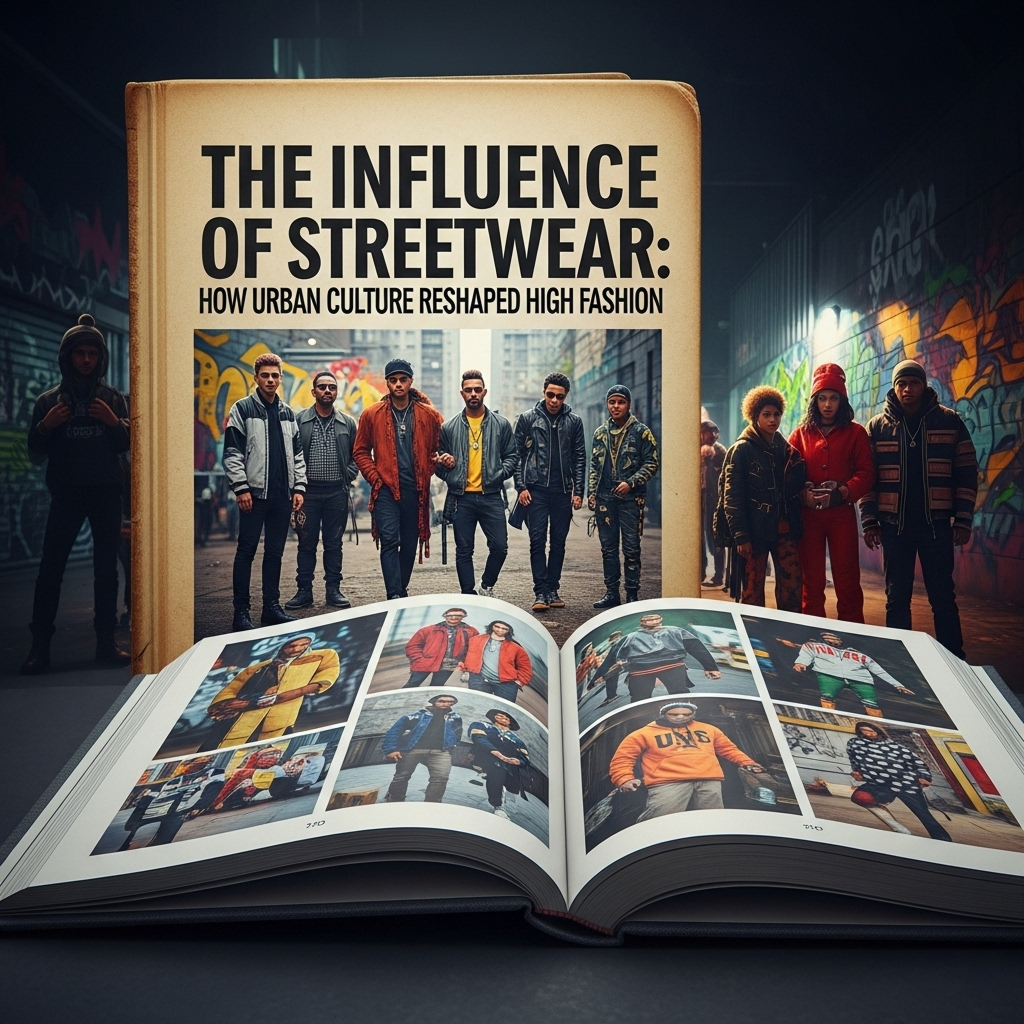Blog
The Influence of Streetwear: How Urban Culture Reshaped High Fashion

For decades, the fashion world operated with a clear hierarchy: high fashion dictated trends from Parisian ateliers, trickle-down to ready-to-wear, and eventually influenced mainstream retail. Meanwhile, on the streets, distinct subcultures forged their own sartorial identities, often dismissed by the elite as niche, anti-establishment, or merely casual wear. Yet, in a seismic shift that few predicted, the raw energy and authentic spirit of streetwear broke through these traditional barriers, not just influencing, but fundamentally reshaping the landscape of high fashion. What began as a rebellious urban aesthetic has now become a dominant global force, blurring lines and redefining luxury for a new generation.
The Genesis: From Surf, Skate, and Hip-Hop
Streetwear’s roots are firmly planted in the vibrant subcultures of the late 20th century. Its origins can be traced back to the surf and skate scenes of California in the 1970s and 80s. Brands like Stüssy, founded by Shawn Stussy in the early 1980s, started by selling surfboards and graphic tees, quickly gaining a cult following among surfers and skaters. These early designs were simple, comfortable, and represented an authentic lifestyle.
Simultaneously, across the country in New York, the burgeoning hip-hop culture of the 1980s and 90s provided another fertile ground for streetwear’s evolution. Artists and fans embraced oversized silhouettes, tracksuits, sneakers, and bold gold chains, creating a distinct aesthetic that celebrated urban identity, comfort, and a certain swagger. Brands like FUBU, Karl Kani, and Sean John emerged from this era, catering directly to the hip-hop community. This wasn’t about fleeting trends dictated by designers; it was about clothing that resonated with real people, on real streets, reflecting their music, their art, and their daily lives.
Key Characteristics: Comfort, Exclusivity, and Graphics
Streetwear’s enduring appeal lies in its core characteristics, which stand in stark contrast to traditional luxury fashion:
Comfort and Casualness: Unlike the restrictive silhouettes of high fashion, streetwear prioritized ease of movement and comfort. Hoodies, t-shirts, sweatpants, and denim became foundational pieces.
Graphic-Heavy Designs: Bold logos, striking graphics, political statements, and pop culture references adorned garments, making them instantly recognizable and expressive. This turned clothes into wearable art and messaging boards.
Exclusivity and Limited Drops: Inspired by sneaker culture, streetwear brands mastered the art of the “drop” – releasing limited quantities of highly anticipated items at irregular intervals. This scarcity fueled immense hype, created long queues (both physical and virtual), and transformed consumer behavior, turning shopping into an event.
Collaborations: Streetwear pioneered the power of collaboration, teaming up with artists, musicians, other brands, and even high-fashion houses. These partnerships created unique, coveted pieces that amplified brand reach and cultural relevance.
The Rise of Sneaker Culture: Perhaps no single item is more emblematic of streetwear than the sneaker. What began as athletic footwear evolved into cultural icons and highly collectible artifacts. Brands like Nike (especially with Jordans) and Adidas (with collaborations like Yeezy) turned sneakers into status symbols, with resale markets often commanding exorbitant prices.
From Niche to Mainstream: The High Fashion Embrace
For years, high fashion remained largely aloof from streetwear, viewing it as a separate, less refined entity. However, as streetwear’s cultural influence and commercial power grew, it became impossible to ignore. The turning point was gradual but undeniable, marked by a handful of visionary designers who understood the pulse of youth culture and the shifting desires of the luxury consumer.
Designers like Riccardo Tisci during his tenure at Givenchy, with his oversized t-shirts and graphic prints, began to subtly introduce streetwear elements into luxury collections. But it was the rise of new guard designers who truly broke the dam:
Virgil Abloh: Perhaps the most pivotal figure, Abloh, with his brand Off-White and later as the Men’s Artistic Director at Louis Vuitton, became the ultimate bridge-builder. He famously stated, “You can put the Hood By Air hoodie next to the Balmain jacket and they’re both high fashion.” His designs for Louis Vuitton, incorporating hoodies, sneakers, and graphic elements, solidified streetwear’s place at the pinnacle of luxury. His use of quotation marks and utilitarian details became instantly recognizable.
Demna Gvasalia: Through his work at Vetements and as Creative Director of Balenciaga, Gvasalia championed an “anti-fashion” aesthetic that drew heavily from everyday wear, oversized silhouettes, and an ironic take on consumerism. His bulky sneakers and DHL t-shirts became iconic, challenging traditional notions of elegance and luxury.
Gosha Rubchinskiy, Heron Preston, and Jerry Lorenzo (Fear of God): These designers, among others, built successful brands by authentically channeling youth culture, skateboarding, hip-hop, and a post-Soviet aesthetic, directly influencing runway trends.
This embrace wasn’t just about incorporating a few hoodies; it was about adopting streetwear’s ethos: its emphasis on comfort, its reliance on graphic messaging, its drop model, and its focus on direct engagement with a community of devoted fans.
The Power of Collaboration and Social Media
Streetwear’s ascent was significantly amplified by two powerful forces:
The Collaboration Phenomenon: The streetwear model of limited-edition collaborations, perfected by brands like Supreme, became a blueprint for luxury. Suddenly, Louis Vuitton was collaborating with Supreme, Dior with Shawn Stüssy, and Prada with Adidas. These unlikely partnerships generated unprecedented hype, introduced luxury brands to new, younger audiences, and solidified the cultural legitimacy of streetwear. They demonstrated that perceived luxury could reside in a limited-edition sneaker just as much as a couture gown.
Social Media and Influencer Impact: Platforms like Instagram and later TikTok became the primary arenas for streetwear’s rapid global expansion. Visual, immediate, and democratic, these platforms allowed trends to disseminate globally at lightning speed. Influencers and tastemakers, often rising from within the streetwear community itself, became new arbiters of style, bypassing traditional fashion gatekeepers. The “flex” culture, showcasing rare and expensive streetwear items, thrived on these platforms, further fueling demand and desirability.
Democratization and Redefining Luxury
Streetwear’s influence has had a profound democratizing effect on fashion. It challenged the notion that luxury was solely about high price tags, exclusive fabrics, or traditional craftsmanship. Instead, it introduced the idea that luxury could be found in scarcity, in cultural relevance, in a powerful brand narrative, and in the authenticity of a lifestyle. A limited-edition graphic tee or a rare pair of sneakers could be just as coveted, if not more so, than a designer handbag.
This shift has forced high fashion to become more accessible, more responsive to consumer desires, and more attuned to the diverse expressions of identity coming from the streets. It has redefined what “cool” means, emphasizing a relaxed, confident aesthetic that prioritizes individual expression over rigid formality.
The Future of Streetwear: A Permanent Fixture
Today, streetwear is no longer a fringe movement; it is an undeniable, permanent fixture at the heart of global fashion. While some purists may argue that its mainstream acceptance has diluted its original rebellious spirit, its impact is irrefutable. It has fundamentally altered the pace of trends, the channels of distribution, and the very definition of luxury.
The future will likely see further blurring of lines. Streetwear elements will continue to infuse formal wear, and comfort will remain a paramount consideration. The emphasis on authentic storytelling, community building, and limited drops will continue to influence how brands operate. As urban culture continues to evolve, so too will streetwear, ensuring its enduring power to shape the future of style. Its journey from skate parks and hip-hop clubs to the grandest runways of Paris is a testament to fashion’s constant capacity for reinvention and its inseparable link to the vibrant tapestry of human culture.
